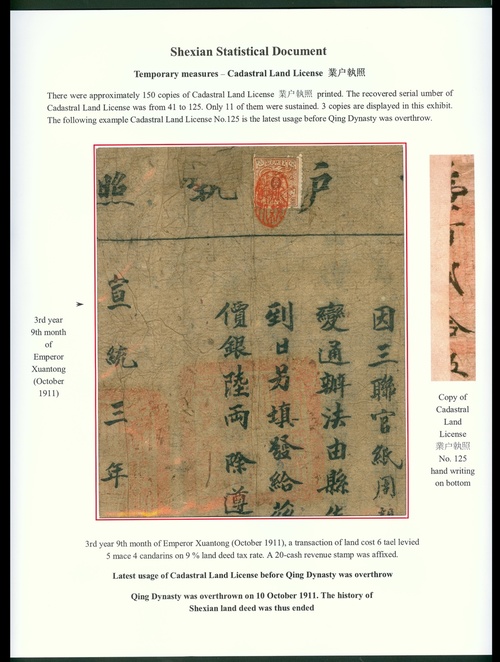
Auction: CSS35 - The Philatelic Collector's Series Sale
Lot: 1395
Micellaneous
Revenue
"Land Tax and Revenue in Shexian, Qing Dynasty 1648-1911" Collection - land tax development and the first revenue stamp used on land deed in China, on 68 exhibit pages.
The first Emperor of Qing Dynasty Shunzhi reinstated Ming Dynasty's land tax system and tax rate at 3%, land deeds were administered by 'An Yuan' - the Chief Secretary. Kangxi, Yongzheng and Qianlong succeeded Shunzhi's land policy and changed the land deed design, Qianlong also switched the administration of land deed tax from Chief Secretary to Cang Fang, which is a county official specially assigned to administer all the grain tribute of the county, land deed tax and annual farm tax was combined to be controlled by single office. During Qianlong's era, three types of Guan Chi chop were used on land deed to warn the tax evaders, the officials and new land owners respectively. Jiaqing relocated the duty of Cang Fang to Ku Fang (the treasury office). The Lunar dater chop was applied during Daoguang's era. Temporary land deed was issued during Taiping Rebellion in Xianfeng's era. Guangxu assigned a new cadastral office to replace Ku Fang and the tax rate of emperor land deed tax increase from 3% to 6% in 1904, and then increase the government land deed tax from 6% to 9% in 1908. In 1908, the revenue stamps were issued which consist of three values, namely 20, 100 and 100 cash printed by The American Bank Note Company in New York. Qing government published the revenue stamp legislation and provision of implementation. Many county governments reluctant to execute this legislation due to heavy tax, Shexian was rigidly enforced to levy revenue stamp. Shexian Statistics Department was established to control land deed tax and oversee usage of revenue stamps, a special oval seal was designed to cancel the revenue stamps. During Xinhai Revolution in 1911, the Cadastral Land License was printed temporarily to substitute the usual deed in Shexian and it was taken over by the Revolution Temporary Government in the same year. The usage of revenue stamps only last for around three years.
This collection examines in details the Land Deed design, levy, control and changes of rate in Shexian which is the first place in China implement the central registration numbering system on Land Tax.
Estimate
HK$550,000 to HK$700,000




